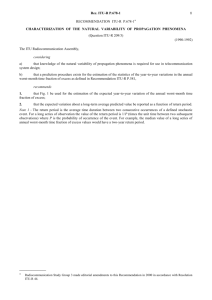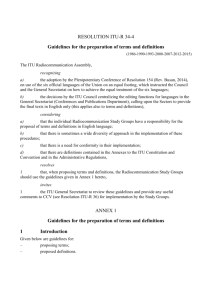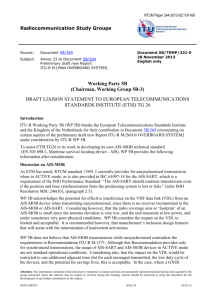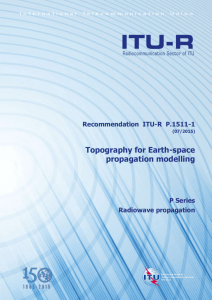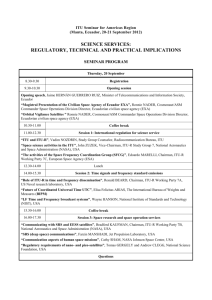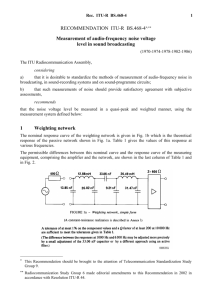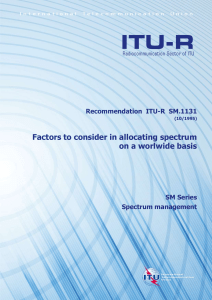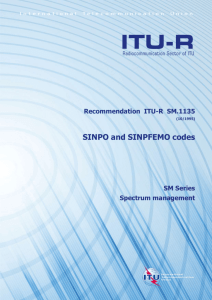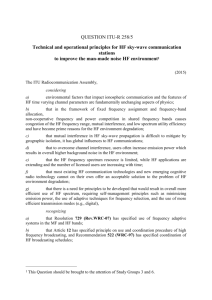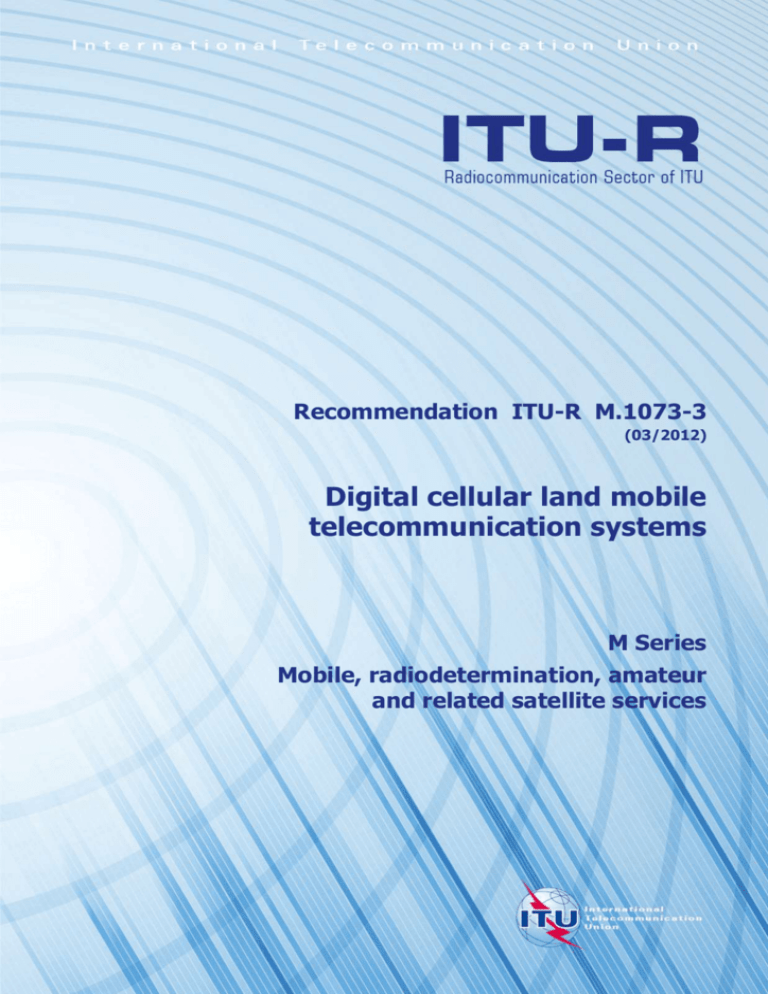
Recommendation ITU-R M.1073-3
(03/2012)
Digital cellular land mobile
telecommunication systems
M Series
Mobile, radiodetermination, amateur
and related satellite services
ii
Rec. ITU-R M.1073-3
Foreword
The role of the Radiocommunication Sector is to ensure the rational, equitable, efficient and economical use of the
radio-frequency spectrum by all radiocommunication services, including satellite services, and carry out studies without
limit of frequency range on the basis of which Recommendations are adopted.
The regulatory and policy functions of the Radiocommunication Sector are performed by World and Regional
Radiocommunication Conferences and Radiocommunication Assemblies supported by Study Groups.
Policy on Intellectual Property Right (IPR)
ITU-R policy on IPR is described in the Common Patent Policy for ITU-T/ITU-R/ISO/IEC referenced in Annex 1 of
Resolution ITU-R 1. Forms to be used for the submission of patent statements and licensing declarations by patent
holders are available from http://www.itu.int/ITU-R/go/patents/en where the Guidelines for Implementation of the
Common Patent Policy for ITU-T/ITU-R/ISO/IEC and the ITU-R patent information database can also be found.
Series of ITU-R Recommendations
(Also available online at http://www.itu.int/publ/R-REC/en)
Series
BO
BR
BS
BT
F
M
P
RA
RS
S
SA
SF
SM
SNG
TF
V
Title
Satellite delivery
Recording for production, archival and play-out; film for television
Broadcasting service (sound)
Broadcasting service (television)
Fixed service
Mobile, radiodetermination, amateur and related satellite services
Radiowave propagation
Radio astronomy
Remote sensing systems
Fixed-satellite service
Space applications and meteorology
Frequency sharing and coordination between fixed-satellite and fixed service systems
Spectrum management
Satellite news gathering
Time signals and frequency standards emissions
Vocabulary and related subjects
Note: This ITU-R Recommendation was approved in English under the procedure detailed in Resolution ITU-R 1.
Electronic Publication
Geneva, 2012
ITU 2012
All rights reserved. No part of this publication may be reproduced, by any means whatsoever, without written permission of ITU.
Rec. ITU-R M.1073-3
1
RECOMMENDATION ITU-R M.1073-3
Digital cellular land mobile telecommunication systems
(1994-1997-2005-2012)
Scope
This Recommendation recommends the technical and operational characteristics of digital cellular land
mobile telecommunication systems for international and regional use. By providing associated references to
the specifications for each technology, the Recommendation provides guidance for administrations
evaluating various cellular systems for their intended applications.
The ITU Radiocommunication Assembly,
considering
a)
that digital signals in various formats are being used to improve the communications
efficiency of the land mobile service;
b)
that digital transmission systems which are not compatible with existing land mobile
systems should also be considered, including the transmission of digitally encoded speech signals;
c)
that mobile telephone services, i.e. services for public correspondence via radio stations
connected to the public switched telephone network (PSTN), are in operation in a number of
countries and that their use is extending;
d)
that the various technical systems already in use or proposed for such services, are not
necessarily compatible;
e)
that system compatibility is necessary in the case of international operation;
f)
that for international operation it is desirable to agree on the parameters of the system;
g)
the need to improve spectrum utilization efficiency and hence system capacity per MHz per
unit area;
h)
the need for a flexible system structure able to match network investment to revenue
growth, readily adapting to environmental factors and responding to new developments rather than
restricting innovation;
j)
the increasing importance of the various types of data and telematic services,
noting
that Recommendation ITU-R M.1457 covers the IMT-2000 radio interfaces,
recommends
that for digital cellular land mobile telecommunication systems (DCLMTS) the following technical
and operational characteristics should be used:
1
General objectives
The general objectives of DCLMTSs are to provide:
–
systems with high spectrum utilization efficiency, thereby accommodating more users
within the limited spectrum resource than existing analogue cellular public land mobile
telecommunication systems (PLMTS);
2
–
–
–
–
–
2
Rec. ITU-R M.1073-3
users with a wide range of services and facilities, both voice and non-voice, that are
compatible with, and access, those offered by the public fixed networks (PSTN, ISDN,
PDN, etc.);
services and facilities exclusive to mobile systems, including facilities for automatic
roaming, locating and updating mobile users;
users with a variety of mobile stations consistent with their requirements, ranging from
vehicle mounted to hand-held stations with voice and non-voice interfaces;
services of high quality and integrity at an economic cost;
mobile equipment and infrastructure at the reduced cost, weight, size and power drain
offered by the adoption of digital processing and very large scale integration (VLSI)
technology.
Digital technology
Digital technology is introduced into the PLMTS in five major areas:
–
digital radio modulation/demodulation;
–
digital speech coding;
–
channel coding and digital signal processing;
–
digital control and data channels;
–
privacy and authentication.
3
Service types
The basic telecommunication services offered by the DCLMTS, as fully described in the reference
material, can be divided into two types:
–
bearer services which give the user the capacity needed to transmit appropriate signals
between certain access points;
–
teleservices which provide the user with the full capacity, including terminal equipment
functions, to communicate with other users.
Supplementary services are also available in association with the basic services.
All the DCLMTS support some services in each category, but the range offered varies between
systems.
3.1
Bearer services
Typical bearer services offered include:
–
synchronous, asynchronous and packet data;
–
unrestricted digital capability at specific bit rates.
In general, connection of voice-band modems to the speech path of mobile stations is not supported.
Equivalent service to that offered by the use of voice-band modems on the PSTN or ISDN can be
provided via the bearer services listed above.
3.2
Teleservices
All the DCLMTS support telephony and facsimile teleservices. Some extend the teleservice
offerings to include videotex, teletex, etc.
Rec. ITU-R M.1073-3
3.3
3
Supplementary services
The range of supplementary services supported by the DCLMTS varies depending on the system
and also the particular implementation.
4
Architecture common to all digital systems
4.1
Base station layout
The geographical distribution of base stations is organized around two types of structure:
–
regular cell structures using omnidirectional antennas;
–
sector cell structures using directional antennas.
4.2
Channel design
Two basic categories of channels are defined for DCLMTS:
–
traffic channels (TCH) which are used for voice and data transmission (i.e. bearer services
and teleservices);
–
control channels (CCH) which are used for signalling and control purposes, including
handover.
The CCH can be further divided into three broad types:
–
common control channels (CCCH) which are used for paging, random access, etc.;
–
broadcast control channels (BCCH) which are used for broadcast messages, and/or
synchronization and frequency correction;
–
associated control channels (ACCH) which can be divided into slow ACCH (SACCH) and
fast ACCH (FACCH) and provide control and signalling functions for individual users.
Some systems may also define other types of control channel for particular applications (e.g. standalone dedicated control channels).
4.3
Network architecture and assignment of functions
Figure 1 shows the basic system architecture for a DCLMTS, including the major functional
components. The communication protocols are specified according to the 7-layer OSI model, while
the interfaces between mobile switching centres (MSCs) and the interfaces to the ISDN, PSTN and
PDN are all specified according to ITU-T Recommendations. The numbering plan also follows
ITU-T Recommendations.
4
Rec. ITU-R M.1073-3
FIGURE 1
Network architecture
EIR
BS
PDNS
PSTN
ISDN
MSC
MS
AUC
HLR
MS
VLR
Fixed
networks
OMC
MSC
Radio
interface
Interface
with the fixed networks
AUC:
BS:
EIR:
HLR:
MS:
MSC:
OMC:
VLR:
authentication centre
base station
equipment identity register
home location register
mobile station
mobile services switching centre
operation and maintenance centre
visitor location register
Physical connection
Logical relationships
5
M.1073-01
Incorporation of externally developed specification material
The detailed standardization of the technologies in this Recommendation has been undertaken
within standards development organizations. This Recommendation therefore makes use of
references to externally developed standards.
6
Digital cellular systems and their enhancements
High capacity digital wireless systems have been developed in all three Regions. Each of the
systems delineated below is incorporated by using a simple reference pointer. References to these
systems are shown in the following Tables.
Rec. ITU-R M.1073-3
6.1
5
GSM
These reference links describe the characteristics of GSM.
Document No.
ETSI
6.2
TS 102 338
Version
1.0.0
Status
Published
Issued date
June 2004
Location
http://pda.etsi.org/exchangefolder/ts
_102338v010000p.pdf
TIA/EIA-136 TDMA
These reference links describe the characteristics of TIA/EIA-136 TDMA.
Document No.
TIA
6.3
TIA-136-000
Version
E
Status
Published ANS
Issued date
Location
2004-01-14
http://ftp.tiaonline.org/uwc136/136000-E.pdf
TIA/EIA-95 CDMA
These reference links describe the characteristics of TIA/EIA-95 CDMA.
Document No.
TIA
6.4
TIA-2000.000
Version
1.0
Status
Published
Issued date
2004-06
Location
http://ftp.tiaonline.org/TR-45/TR45.5/Public/ITUM1073/TIA2000.00_CDMA_List%20of%20Std
s.doc
PDC
These reference links describe the characteristics of PDC.
Document No.
ARIB
RCR STD-27
Version
L
Status
Published
Issued date
Nov. 2005
Location
http://www.arib.or.jp/english/html/o
verview/doc/5-STD-27_L-1p3-E.pdf
http://www.arib.or.jp/english/html/o
verview/doc/5-STD-27_L-2p3-E.pdf
http://www.arib.or.jp/english/html/o
verview/doc/5-STD-27_L-3p3-E.pdf

